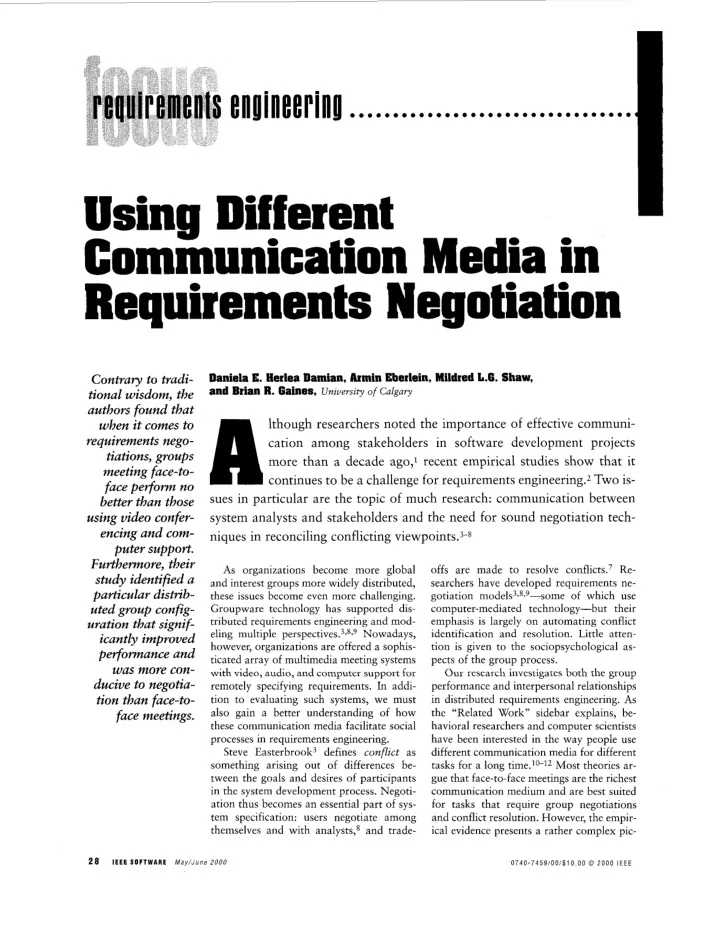

. zyxwvutsrqponmlkjihgfedcbaZYXWVUTSRQPONMLKJIHGFEDCBA M zyxwvutsrqponmlkjihgfedcbaZYXWVUTSRQPONMLKJIHGFEDCBA .......... zyxwvutsrqponmlkjihgfedcbaZYXWVUTSRQPONMLKJIHGFEDCBA Requirements Negotiation zyxwvutsrqponmlkjihgfedcbaZYXWVUTSRQPONMLKJIHGFEDCBA I .....a zyxwvutsrqponmlkjihgfedcbaZYXWVUTSRQPONMLKJIHGFEDCBA . . . . . . engineer i n ! . . . . . . . . I . . and Brian R. Gaines, University zyxwvutsrqponmlkjihgfedcbaZYXWVUTSRQPONMLKJIHGFEDCBA face perform zyxwvutsrqponmlkjihgfedcbaZYXWVUTSRQPONMLKJIHGFEDCBA Daniela E. Herlea Damian, bmin Eberlein, Mildred L.G. Shaw, Contrary to tradi- tional wisdom, the of Calgary A authors found that lthough researchers noted the importance of effective communi- when it comes to requirements nego- cation among stakeholders in software development projects tiations, groups more than a decade ago,l recent empirical studies show that it meeting face-to- continues to be a challenge for requirements engineering2 Two is- no sues in particular are the topic of much research: communication between better than those using video confer- system analysts and stakeholders and the need for sound negotiation tech- encing and com- niques in reconciling conflicting viewpoints.3-* puter support. Furthermore, their As organizations become more global offs are made to resolve conflicts.’ Re- study identified a and interest groups more widely distributed, searchers have developed requirements ne- particular distrib- these issues become even more challenging. gotiation m~dels~~*~~-some of which use uted group config- Groupware technology has supported dis- computer-mediated technology-but their tributed requirements engineering and mod- emphasis is largely on automating conflict uration that signif- eling multiple perspective^.^>^.^ Nowadays, identification and resolution. Little atten- icantly improved however, organizations are offered a sophis- tion is given to the sociopsychological as- performance and ticated array of multimedia meeting systems pects of the group process. was more con- with video, audio, and computer support for Our research investigates both the group ducive to negotia- remotely specifying requirements. In addi- performance and interpersonal relationships in distributed requirements engineering. As tion than face-to- tion to evaluating such systems, we must also gain a better understanding of how the “Related Work” sidebar explains, be- face meetings. these communication media facilitate social havioral researchers and computer scientists processes in requirements engineering. have been interested in the way people use Steve Easterbrook3 defines conflict as different communication media for different something arising out of differences be- tasks for a long time.1°-12 Most theories ar- tween the goals and desires of participants gue that face-to-face meetings are the richest in the system development process. Negoti- communication medium and are best suited ation thus becomes an essential part of sys- for tasks that require group negotiations tem specification: users negotiate among and conflict resolution. However, the empir- themselves and with analysts,8 and trade- ical evidence presents a rather complex pic- 28 IEEE SOFTWARE May/Jone 2000 0740-7459/00/$10.00 @ 2000 I E E E
Distributed 1 (Dl) Distributed 2 (D2) Room 2 zyxwvutsrqponmlkjihgfedcbaZYXWVUTSRQPONMLKJIHGFEDCBA Customer 1 zyxwvutsrqponmlkjihgfedcbaZYXWVUTSRQPONMLKJIHGFEDCBA I I Room 1 Room 1 Room 2 Face-to-face (F2F) Distributed 3 (03) Distributed 4 (D4) Facilitator Customer 1 Room2 zyxwvutsrqponmlkjihgfedcbaZYXWVUTSRQPONMLKJIHGFEDCBA @-@ Fa Customer 2 System Customer 2 gated the effects on group performance of and zyxwvutsrqponmlkjihgfedcbaZYXWVUTSRQPONMLKJIHGFEDCBA Customer 2 analyst @ } @ I ) Room1 Room 1 Room 2 Figure 1 . Five physi- with that of distributed groups using real- cal group ConfWa- ture and offers no definite support to such time computer conferencing. We investi- tions: (a) face-to-face claims.12 Much of the existing research, for (b) four distrib- example, focuses on how users perceive or both the communication media and differ- uted communication choose media, rather than on a particular ent physical configurations of customers and SettingS. medium’s effect on objective task perform- developers. We used a mixed-method re- ance. When researchers tested the objective search approach that uses quantitative group- performance for equivocal and cognitive conflict tasks,13J4 groups performed better performance measures and qualitative in- using other media-such as video phones, quiries into the group behavior in computer- telephones, and computer-mediated commu- mediated meetings. nications-than they did face-to-face. Research Design Among the questions in requirements engi- We designed a simplified scenario that il- neering that need further investigation are whether group performance improves over lustrates the conflict between requirements face-to-face meetings if the stakeholders com- scope and resource constraints. Our sce- municate using multimedia systems that inte- nario involves the communication between grate video, audio, and shared electronic files a system analyst and two customers, medi- (hereafter referred to as computer conferenc- ated by a facilitator. The two customers were ing.) Also, from a sociopsychological perspec- from two different organizational units and had different perspectives on the system to tive, an interesting question is whether stake- be developed. The system analyst insists holders with conflicting requirements better manage conflict when they are colocated or that it is impossible to implement the system illustrates, we zyxwvutsrqponmlkjihgfedcbaZYXWVUTSRQPONMLKJIHGFEDCBA ing requirements in face-to-face meetings zyxwvutsrqponmlkjihgfedcbaZYXWVUTSRQPONMLKJIHGFEDCBA physically separated. As these unanswered in the given time frame, and thus the cus- questions illustrate, communication technol- tomers must agree on a subset of the origi- ogy might be impressive, but little systematic nal requirements. This triggered a conflict between the customers’ needs. research exists on its social and psychological significance for requirements engineering. Using this scenario, we designed our in- vestigation with two goals. First, we wanted As a step in this direction, we report here to investigate the communication media’s on our laboratory experiment that com- effects on group performance in negotiating pared the performance of groups negotiat- the requirements. As Figure 1 29 May/June 2000 I E E E SOFTWARE
Recommend
More recommend